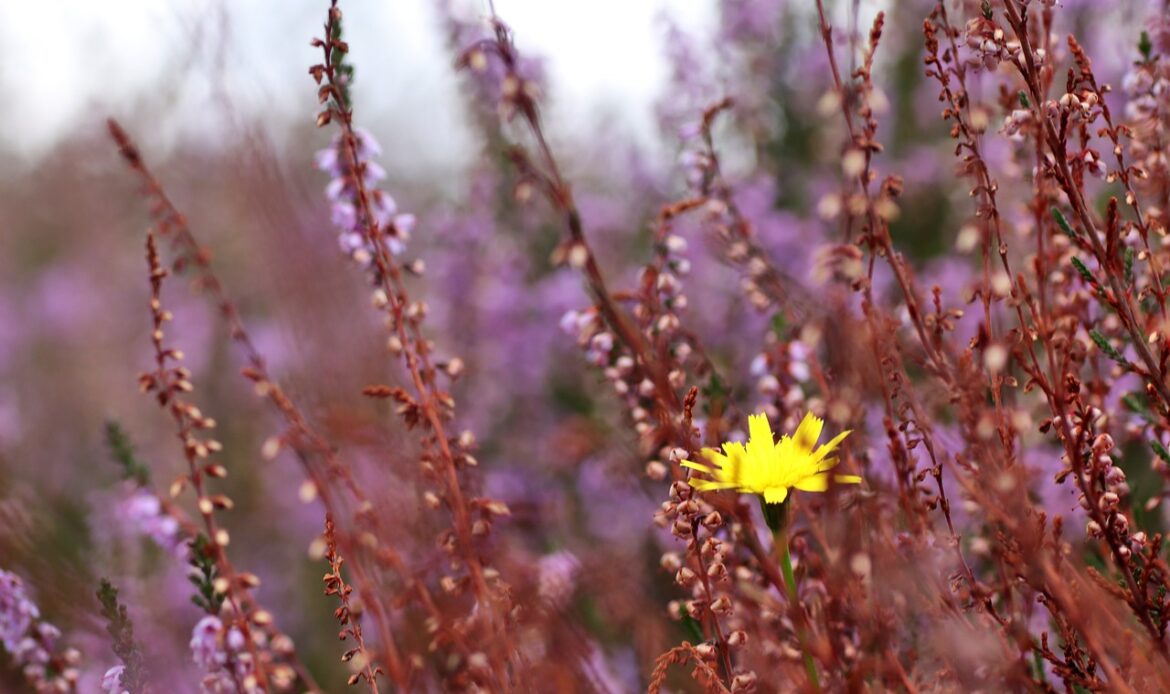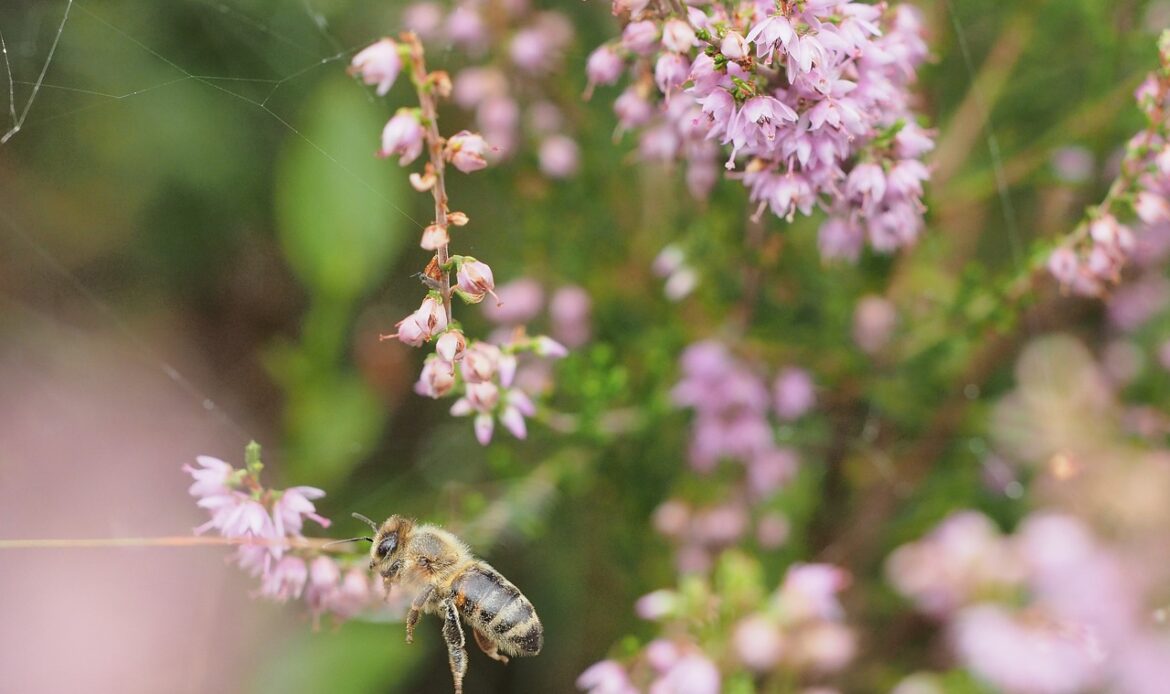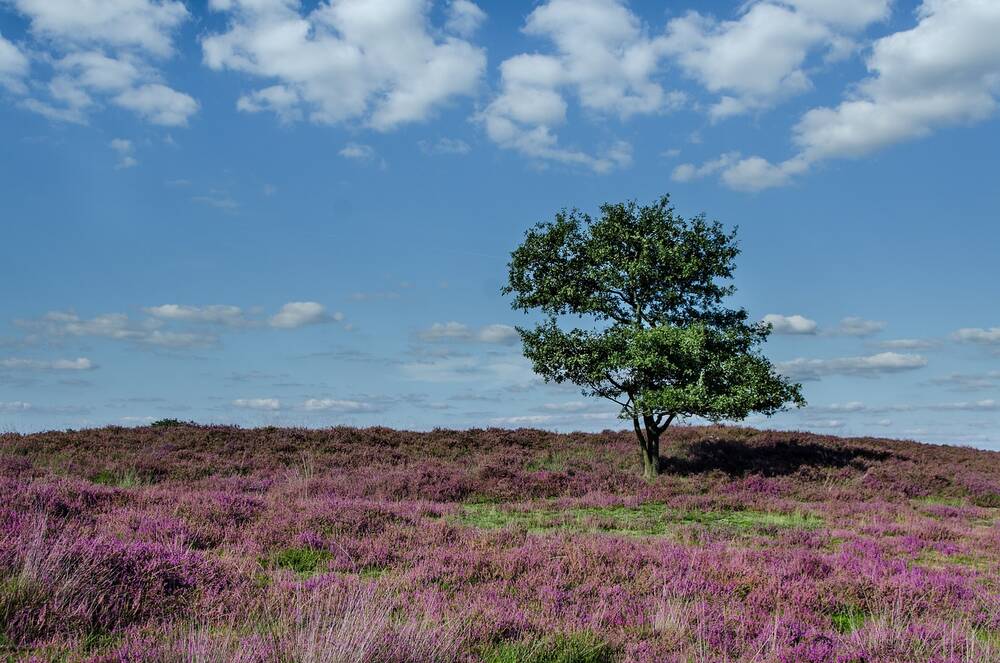Heathland habitats are home to many specialised, rare species, as well as a rich diversity of wildlife. Once widespread across the UK, the habitats have since faced significant habitat loss. They consist of open landscapes packed with low-growing vegetation; most commonly a combination of heather and gorse.
This article covers the history of heathlands, their key features, and the various types of heathlands (including lowland, upland, coastal, wet, dry, montane, dune, and alpine). We then cover the main animals and plants found in these habitats, the reason for the widespread habitat loss, key statistics, as well as the conservation steps being made to counteract this and keep these crucial, biodiversity hotspots strong and intact.
What are Heathland Habitats?
Heathlands as we know them today are largely a result of human activity over thousands of years. They are open landscapes with acidic and nutrient-poor soils, allowing dense, low-growing vegetation like heather, gorse and grasses to thrive. They favour temperate regions, hence are more common in the south of England, however, they occur throughout the entire UK.
Although they host natural ecosystems, heathlands have been shaped by human intervention over time, and must also be managed by human intervention. These landscapes provide a habitat for some rare, specialised species, which depend on routine care to maintain ecological balance. Key methods include grazing, selective deforestation, and controlled burns—intentional, carefully managed fires that reduce overgrown vegetation. They are also highly susceptible to external threats, contributing to their significant loss.
The History of Heathlands
In the UK and parts of Europe, heathland habitats bear a significant cultural history.
In the Neolithic and Bronze Age, around 5,000 years ago, people began cutting down forests in order to make open spaces for agriculture. Grazing was soon implemented to prevent tree growth, allowing for open, low-nutrient heathland landscapes.
In mediaeval times, heathlands provided land for livestock, fuel from peat, and heather for making brooms or thatching roofs.
The land was also used for military training through both World Wars, such as England’s Salisbury Plain, where soldiers practised combat, trench warfare, or artillery exercises.
In some regions, heathlands have been historically associated with superstitions or folklore. Their untamed, rugged nature bore connotations of supernatural entities, witches and spirits.
Key Features of Heathland Habitats
Heathland habitats are easily identified by their dense, low-growing vegetation, within a vast open landscape. Their flora tend to be a combination of gorse, heather, and grasses, thriving in nutrient-poor, acidic soils, within a delicate, balanced ecosystem that is quite susceptible to external harm, making them a highly threatened habitat. They’re found in temperate regions and offer crucial spots for biodiversity, supporting specialised species that you might not find anywhere else.
Heathlands are visually striking, especially when dense vegetation is in bloom, with packs of purple and greens from the heather, combined with gorse’s scrubby bushes and yellow flowers and coarse grasses.
Grazing ponies and sheep enhance both the biodiversity and the scenic quality of these habitats.
The Different Types of Heathland Habitat

Lowland Heathland
Lowland heathlands occur most frequently in the UK and other temperate regions. They occur at altitudes lower than 300 metres, packed with shrubby vegetation like gorse and heather which are prevalent throughout.
These heathlands feature a mix of wet and dry microhabitats with nutrient-poor, acidic peaty or sandy soils, supporting a limited variety of plant life. The habitats are species for the Dartford Warbler bird and the Silver-studded Blue Butterfly, and due to their warmer temperatures, reptiles like the smooth snake and the common lizard can thrive.
Upland Heathland
In contrast, upland heathlands are usually situated above 300 metres. They are an open, exposed habitat on mountains or hills, and also consist of shrubby heather and other hardy plants. They can be more vulnerable to soil erosion due to heavy rainfall, plus colder temperatures, thin soils and high winds.
These conditions cause slower decomposition of plant material, leading to an accumulation of peat, which holds water well. Because of this, they can store large amounts of carbon, making upland heathlands crucial in climate change mitigation.
Coastal Heathland
Coastal heathlands are beautiful habitats that form along cliffs or on sandy shores, exposed to coastal winds and salt sprays. They support a range of salt-tolerant species, like heather, sea thrift, and scurvy grass.
These habitats are some of the most at risk, and many efforts are in place to conserve them. Conservation efforts aim to reduce coastal erosion and protect important habitats for wildlife such as the breeding grounds of seabirds.
They also support rare species that have adapted to the specialised habitat, like the coastal heath moth and the sea aster mining bee.
Wet Heath
A wet heath features waterlogged soils and is often found at the bottom of valleys or in low-lying areas that retain moisture. They support a range of plants adapted to boggy, wet, acidic conditions, including rare species of dragonflies and damselflies.
These habitats also accumulate peat, less prevalent in the drier heathlands, and therefore play a key role in carbon storage and mitigating climate change.
The waterlogged conditions feature a range of amphibians like the common frog and newt.
Dry Heath
In contrast, dry heath is found on gravelly or sandy soils, leading to more arid conditions and supporting a range of drought-resistant plants like dwarf shrubs and bell heather.
It supports many reptiles, like the smooth snake and adder, which would struggle in high-altitude, colder environments.
Ground-nesting birds utilise the open, dry areas for nesting and camouflage, which they may struggle to do in wetter habitats.
Gorse is a nitrogen-fixing plant, enabling it to thrive, enabling it to thrive in nutrient-poor soils.
Montane Heath
Montane heath is found at high altitudes in mountainous regions, offering a unique habitat for alpine species like the ptarmigan bird or the colour-changing mountain hare.
Far above the tree line where snow is frequent, montane heaths feature cushion plants, mosses, and lichens, adapted to the harsh conditions and rocky, nutrient-poor, shallow soils.
These hardy plants grow together to create dense, low clusters to conserve heat and moisture. Other species like arctic-alpine willows cling to the ground, creating a stark yet beautiful landscape that’s perfectly tailored to survive extreme weather.
Dune Heath
Dune heathland habitats form along coastal sand dunes, providing a unique habitat for species adapted to sandy, nutrient-poor soils and the salt-laden sea breeze.
They are very rare habitats that only form on the older and more stable sand dunes.
Just inland from beaches, dune heaths develop on sandy soil. These become stabilised by the established root systems of hardy plants like Marram Grass, Creeping Willow, and heather, preventing coastal erosion and protecting shorelines.
These habitats act as a transition zone between inland habitats and beach dunes, offering open sandy areas as well as shrubby cover, such as the Natterjack Toad.
They are fragile ecosystems, easily harmed by development, trampling, fire, or other human activities.
Alpine Heath
While montane heath typically occurs between 500 and 1,500 metres, alpine heath occurs at some of the highest altitudes, usually above 2,000 metres, and in very extreme conditions.
The plants are significantly hardy, able to withstand intensive winds, severe low temperatures and a small window of time to grow. This is predominantly mosses, lichens, dwarf shrubs and cushion plants.
At higher altitudes, they are more prone to constant snow or frozen states. Rocky, thin soils force plants to spread out, so they cluster and grow together for warmth, and to reduce water loss.
Their leaves are often small, waxy, or hairy, helping to retain moisture and withstand freezing temperatures. Additionally, alpine heath plants are highly efficient at photosynthesis, maximising energy intake during their brief growing season.
Animals & Plants That Live In Heathland Habitats

Mammals
Heathland habitats can support a wide range of mammals, such as European Rabbits, which graze and burrow in the open spaces, and weasels and stoats, which utilise the vegetation’s packed foliage for ample protection and shelter.
Hedgehogs feed on vertebrates and invertebrates, also benefiting from the dense shrubbery. Bat species such as the Pipistrelle come out at night, easily finding insects in open spaces as a primary food source.
Foxes are frequently spotted in heathland habitats, preying on birds, rabbits, and insects or using the foliage for shelter. Others include deer (especially roe deer), voles, shrews, and even otters can be found in areas with watercourses.
Birds
Some nightjar birds come out at night in heathland habitats, in convenient camouflage with the vegetation, allowing them to feed on moths and other insects.
The Dartford Warbler is a famous bird of the heathland, thriving within the gorse heather, and commonly spotted in southern UK heathlands on a warm day, as little birds hide from the wind.
Stonechats also use heathlands and sometimes can come through migratory routes from North Africa or Southern Europe. Return migration is in spring, when they can breed in the heathlands, enjoying the open, insect-rich environment filled with shrubs, providing shelter and food.
Reptiles & Amphibians
Heathland habitats are home to a wide range of amphibians and reptiles, as their open landscapes allow for direct sunlight to heat the sandy soils, creating ideal basking spots that are also protected by dense vegetation. Heathlands also attract many types of smaller prey, essential for the survival of reptiles.
Commonly, you can find the sand lizard, which basks and burrows in the sandy soils, and the adder, which camouflages well amongst the heather and is the UK’s only venomous snake.
Harder to encounter is the smooth snake, covered under the gorse vegetation, which lives in the space to hunt for insects and breed.
Plants
Heathland habitats mostly consist of low-growing, hardy plants that are well-adapted to open, windy conditions as well as poor or acidic soils. Dominated by heather, blooming seasons will boast a colourful, thick carpet with a mix of Ling and Bell Heather.
The structure is provided by gorse, with yellow flowers and spiky branches, offering essential shelter and protection to many animals. A low-growing variant of this is Dwarf Gorse, thriving in dry soils, and contributing further to the dense floor of plants provided by a heath habitat.
In damper heathland areas, Purple Moor Grass and Cross-leaved Heath can thrive, creating ecologically niche habitats for specialised species such as the Silver-studded Blue Butterfly or the Smooth Snake.
Loss of Heathland in Recent Years
Coastal, lowland, and dune heathlands face high threats from human activities and climate change, whereas upland and alpine heathlands are less at risk due to their remote locations and minimal human disturbance.
The vast majority of heathland habitats have been lost in the South of England due to urbanisation, agricultural expansion, afforestation and development. This has been especially heightened in recent years due to the mass planting of invasive conifer trees for timber (like pine and spruce).
They are often dismissed as barren “wastelands” due to a lack of immediate visibility of biodiversity, leading to their destruction in favour of land considered more economically productive.
The unique ecosystems that crucially support rare, specialised species like the Dartford Warbler and the Sand Lizard, are more and more threatened. Large, thriving heathland habitats can be fragmented by buildings, roads, and other land uses.
This weakens structures of nature and leads to ecosystem collapse, unsupported by declines in population, increases of invasive species, and a lack of habitat connectivity.
Threats & Conservation
Heathlands’ nutrient-poor soils are particularly vulnerable to pollution, land use changes, and any other disturbances. A delicate balance must be maintained between open landscapes, low nutrient levels in soil, specific plant species plus a periodic routine of management.
Nitrogen and ammonia from agricultural fertilisers or livestock, or sulphur dioxide from burning fossil fuels, disrupt the growth of heather and other native plants essential for the habitat’s ecosystem health.
The Wildlife Trusts play a major role in heathland conservation across the UK, with various restoration techniques like conifer removal, traditional grazing reintroductions, and nutrient-rich topsoil removal, allowing heather and gorse to thrive in their ideal soil conditions.
The Trusts also connect fragmented heathlands, ensuring habitat connectivity and strengthening ecosystems for environmental changes.
Heathland Habitats Facts & Stats
- The Dartford Warbler population crashed to just 11 pairs after 2 harsh winters, then up to 3,214 pairs in 2006, which has been maintained until now, however, they are still classified as Near Threatened on the IUCN Global Red List.
- Around 80% of heathland habitats have been lost in the UK over the last 200 years, especially lowland, due to neglect, housing developments, confider planting, and agricultural expansion.
- The Heathlands Reunited project has now enhanced and conserved an impressive 23,825 hectares of lowland heath, massively supporting biodiversity and heathland habitats across in England.
More Information
https://www.bto.org/understanding-birds/birdfacts/dartford-warbler
https://www.wildlifetrusts.org/habitats/heathland-and-moorland
https://www.woodlandtrust.org.uk/trees-woods-and-wildlife/habitats/heathland-and-moorland
https://data.jncc.gov.uk/data/b0b5e833-7300-4234-8ae5-bdbf326e854c/habitat-types-lowland-heath.pdf
https://www.cumbriawildlifetrust.org.uk/habitats/heathland-and-moorland

